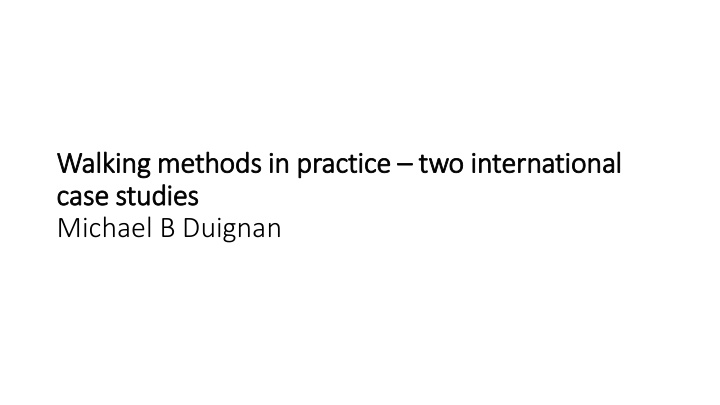



Wal alki king m method ods in p prac acti tice – two i o intern rnati tional al case ase s stu tudies Michael B Duignan
• “In what way can an amalgam of embodied and digital practices be utilised to better understand and more deeply interrogate the spatial arrangement and impact on urban space on host Olympic cities?” • Little systematic and empirical evidence looks at the way Olympics territorialises and takes over ‘host cities’ – before and during ‘live staging’ periods and how this produces inclusion of some and exclusion of others’ interests in the melee of Olympic organising.
• Rio case illustrates ‘live staging’ and • Tokyo 2020 case illustrates the ‘lead up’
• Walking method not only helps understand how events shape physical space, but what the socio-spatial implications are and critically whose interests are included vs. excluded across temporary urban arrangements.
• Highly localised, idiosyncratic insights that may not be revealed by other methods like survey, interviewing and only using static imagery like photos when interpreting the data • New way of thinking and understanding beyond entrenched traditional methodological choices and evaluative approaches • Increasingly post-positivist epistemological positions • Lines of inquiry that seek to avoid reductionism: accepting messy, complex, contested, contradictory and even paradoxical processes and implications
#RioZones approach • Action focused research: immersive, ethnographic, activist to reveal reality and worse excesses of events • Physical, immersive, sensory, affective methods
#RioZones approach • Phase 1: immediately before and during live staging (31 July – 8 August 2016) • Phase 2: immediately after live staging (August – September 2016) • Phase 3: 2 years on (March – April, 2018)
#RioZones approach – Phase 1 • 10-day observational period, across ‘Host Event Zones’ (demarcated areas to host activity) • ‘Last Mile’ spaces that serve as arteries to and from venues typically from transport hubs • Olympic Stadium, Maracana Stadium, Copacabana stadium and Live Site at Porto Maravilha (Olympic Boulevard) that played host to live screens and sponsor activation + food vendors • Approximate the gaze of a tourist – following prescribed paths + promoted space • Bring research closer to phenomena in question, expose researchers to multi-dimensional, multi-sensory experience of event, especially extreme event environments (Adams and Guy, 2007)
#RioZones approach – Phase 1 • Soundscapes (music, general vibe), smells (e.g. street trader food) and collective gatherings (atmosphere) • Preparation – prior to arriving in Rio - examined official Olympic and public documents (e.g. maps, VisitRio) to familiarise with the host’s geographical and site context.
#RioZones approach – Phase 1 – physical methods and tools • Observational data gathered through walking planned routes • Geotagged photos (over 2000 photos generated) • Auditory techniques (hours of audio narration of spaces under investigation recorded) • Geotagged video capture (over 400 videos captured) • Analysis of archival and media reports – before during and after Rio 2016 (e.g. event sites, official Rio 2016 publications) • Interviews (Phase 1 and Phase 2)
#RioZones approach – Phase 1 – research questions • What kind of public spaces were sequestrated and territorialised and why • How were these urban spaces spatially organised and zoned, and what human (e.g. security personnel, Games volunteers) and non-human actors (e.g. signage, barriers) actors were responsible for organising and affording such conditions • What were the associated spatial impacts on visitor flow, circulations and the creation of festival atmospheres across the Olympic city?
#RioZones approach – Phase 1 – observations • Individuals subverted social controls and spatial arrangements exhibiting localized micro resistances. Micro entrepreneurs peddling unofficial goods, local food and drinks rivalling bland corporate offer • Spaces were less controlled and why they were down to less regulation, less enforcement, cracks in barriers and wayfinding that allowed tourist out of typically tightly controlled zones and micro entrepreneurs in to leverage the spectator crowds
Recommend
More recommend